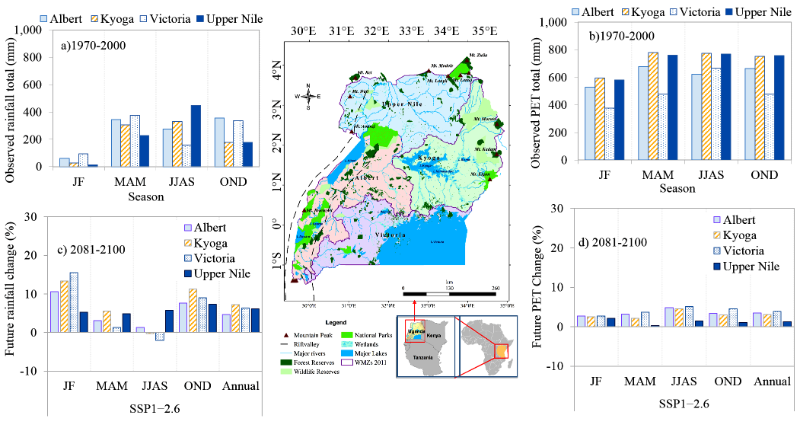Water availability trends across water management zones in Uganda
5684 views
- bitwire2010
-
Topic AuthorLess
- Posts: 14
- Likes received: 2
Re: Observed and Future Precipitation and Evapotranspiration in Water Management Zones of Uganda: CMIP6 Projections
Dear members
There is an open access, peer reviewed article based on results from my dissertation on Climate Change Impacts on Precipitation and Potential Evapotranspiration across Water Management Zones in Uganda in partial fulfilment of the requirements for the award of Master of Science in Water and Sanitation Engineering of Kyambogo University Uganda.
ONYUTHA, C., ASIIMWE, A., AYUGI, B., NGOMA, H., ONGOMA, V., TABARI, H. (2021) Observed and Future Precipitation and Evapotranspiration in Water Management Zones of Uganda: CMIP6 Projections. Atmosphere 2021, 12, 887. doi.org/10.3390/atmos12070887
Climate change will impact on PET and precipitation disproportionately across Uganda.
(Note: Abstract and graphical abstract added below by moderator PCP)
Abstract:
We used CMIP6 GCMs to quantify climate change impacts on precipitation and potential evapotranspiration (PET) across water management zones (WMZs) in Uganda. Future changes are assessed based on four Shared Socioeconomic Pathways (SSP) scenarios including SSP1-2.6, SSP2-4.5, SSP3-7.0, and SSP5-8.5 over the periods 2021–2040, 2041–2060, 2061–2080, and 2081–2100. Both precipitation and PET are generally projected to increase across all the WMZs. Annual PET in the 2030s, 2050s, 2070s, 2090s will increase in the ranges 1.1–4.0%, 4.8–7.9%, 5.1–11.8%, and 5.3–17.1%, respectively. For the respective periods, annual precipitation will increase in the ranges 4.0–7.8%, 7.8–12.5%, 7.9–19.9%, and 6.9–26.3%. The lower and upper limits of these change ranges for both precipitation and PET are, respectively, derived under SSP1-2.6 and SSP5-8.5 scenarios. Climate change will impact on PET or precipitation disproportionately across the WMZs. While the eastern WMZ (Kyoga) will experience the largest projected precipitation increase especially towards the end of the century, the southern WMZ (Victoria) exhibited the largest PET increase. Our findings are relevant for understanding hydrological impacts of climate change across Uganda, in the background of global warming. Thus, the water sector should devise and implement adaptation measures to impede future socioeconomic and environmental crises in the country.
There is an open access, peer reviewed article based on results from my dissertation on Climate Change Impacts on Precipitation and Potential Evapotranspiration across Water Management Zones in Uganda in partial fulfilment of the requirements for the award of Master of Science in Water and Sanitation Engineering of Kyambogo University Uganda.
ONYUTHA, C., ASIIMWE, A., AYUGI, B., NGOMA, H., ONGOMA, V., TABARI, H. (2021) Observed and Future Precipitation and Evapotranspiration in Water Management Zones of Uganda: CMIP6 Projections. Atmosphere 2021, 12, 887. doi.org/10.3390/atmos12070887
Climate change will impact on PET and precipitation disproportionately across Uganda.
(Note: Abstract and graphical abstract added below by moderator PCP)
Abstract:
We used CMIP6 GCMs to quantify climate change impacts on precipitation and potential evapotranspiration (PET) across water management zones (WMZs) in Uganda. Future changes are assessed based on four Shared Socioeconomic Pathways (SSP) scenarios including SSP1-2.6, SSP2-4.5, SSP3-7.0, and SSP5-8.5 over the periods 2021–2040, 2041–2060, 2061–2080, and 2081–2100. Both precipitation and PET are generally projected to increase across all the WMZs. Annual PET in the 2030s, 2050s, 2070s, 2090s will increase in the ranges 1.1–4.0%, 4.8–7.9%, 5.1–11.8%, and 5.3–17.1%, respectively. For the respective periods, annual precipitation will increase in the ranges 4.0–7.8%, 7.8–12.5%, 7.9–19.9%, and 6.9–26.3%. The lower and upper limits of these change ranges for both precipitation and PET are, respectively, derived under SSP1-2.6 and SSP5-8.5 scenarios. Climate change will impact on PET or precipitation disproportionately across the WMZs. While the eastern WMZ (Kyoga) will experience the largest projected precipitation increase especially towards the end of the century, the southern WMZ (Victoria) exhibited the largest PET increase. Our findings are relevant for understanding hydrological impacts of climate change across Uganda, in the background of global warming. Thus, the water sector should devise and implement adaptation measures to impede future socioeconomic and environmental crises in the country.
Attachments:
Please Log in to join the conversation.
You need to login to reply- bitwire2010
-
Topic AuthorLess
- Posts: 14
- Likes received: 2
Re: Water availability trends across water management zones in Uganda
Dear Chaiwe
Thanks for getting time to read through my publication.
Climate change is real. CAREFULLY PLANNED MITIGATION MEASURES ARE REQUIRED.
Thanks for getting time to read through my publication.
Climate change is real. CAREFULLY PLANNED MITIGATION MEASURES ARE REQUIRED.
The following user(s) like this post: Chaiwe
Please Log in to join the conversation.
You need to login to reply- Chaiwe
-

- Moderator
- Innovation enthusiast and Knowledge Management Expert in WASH and Climate Change while cross-cutting Youth and Gender Issues. CEO of CaDev_Capacity Development (An African Social Enterprise)
Less- Posts: 336
- Karma: 8
- Likes received: 116
Re: Water availability trends across water management zones in Uganda
Dear Arnold Asiimwe,
I would first like to congratulate you on the publication of your article, ''Water availability trends across water management zones in Uganda.'' The Article is indeed informative and can be helpful in the Water Sector, hence why I am commenting to bring your post back to the top so that it can catch the attention of more forum users.
It is great that within your research, you highlight Uganda's Vision 2040 master plan (which begun in 2013) and was conceptualized with a focus on strengthening the fundamentals of that country’s economy. The vision considers harnessing the abundant opportunities in water resources among many other sectors and this is worth mentioning.
Moreover, I think it is a good initiative to understand variations in hydro-climatic variables such as precipitation, potential evapotranspiration (PET), river flow, and temperature because these do enable the prediction and support in the planning of water supply trends i.e availability/scarcity brought about by factors such as climate change.
Looking at the study's findings, the study is important for planning purposes in the near future concerning water resources management not just in Uganda but also within different countries as well.
Regards,
Chaiwe
I would first like to congratulate you on the publication of your article, ''Water availability trends across water management zones in Uganda.'' The Article is indeed informative and can be helpful in the Water Sector, hence why I am commenting to bring your post back to the top so that it can catch the attention of more forum users.
It is great that within your research, you highlight Uganda's Vision 2040 master plan (which begun in 2013) and was conceptualized with a focus on strengthening the fundamentals of that country’s economy. The vision considers harnessing the abundant opportunities in water resources among many other sectors and this is worth mentioning.
Moreover, I think it is a good initiative to understand variations in hydro-climatic variables such as precipitation, potential evapotranspiration (PET), river flow, and temperature because these do enable the prediction and support in the planning of water supply trends i.e availability/scarcity brought about by factors such as climate change.
Looking at the study's findings, the study is important for planning purposes in the near future concerning water resources management not just in Uganda but also within different countries as well.
Regards,
Chaiwe
SuSanA Forum Moderator
Skat Foundation (With financial support by GIZ and SIRWASH up to November 2023)
Chaiwe Mushauko-Sanderse BSc. NRM, MPH
Independent consultant located in Lusaka, Zambia
Emails: This email address is being protected from spambots. You need JavaScript enabled to view it., This email address is being protected from spambots. You need JavaScript enabled to view it.
LinkedIn: www.linkedin.com/in/chaiwe-mushauko-sanderse-21709129/
Twitter: @ChaiweSanderse
Skat Foundation (With financial support by GIZ and SIRWASH up to November 2023)
Chaiwe Mushauko-Sanderse BSc. NRM, MPH
Independent consultant located in Lusaka, Zambia
Emails: This email address is being protected from spambots. You need JavaScript enabled to view it., This email address is being protected from spambots. You need JavaScript enabled to view it.
LinkedIn: www.linkedin.com/in/chaiwe-mushauko-sanderse-21709129/
Twitter: @ChaiweSanderse
Please Log in to join the conversation.
You need to login to reply- bitwire2010
-
Topic AuthorLess
- Posts: 14
- Likes received: 2
Water availability trends across water management zones in Uganda
Dear members
I am glad to announce that my Article Titled Water availability trends across water management zones in Uganda from my Masters research titled ClimateChange Impacts on Precipitation and Potential Evapotranspiration across Water
Management Zones in Uganda was published.
The published article can be found via this link: doi.org/10.1002/asl.1059
Hope the article can be helpful for anyone or organization in need of such information.
I can be reached for any inquiries.
Thanks
++++++
Abstract:
This study assessed trends in gridded (0.25° × 0.25°) Climate Forecast System Reanalysis (CFSR) precipitation, potential evapotranspiration (PET), and precipitation minus PET (PMP) across the four water management zones (WMZs) in Uganda including Kyoga, Victoria, Albert, and Upper Nile. The period considered was 1979–2013. Validation of CFSR datasets was conducted using precipitation observed at eight meteorological stations across the country. Observed precipitation trend direction was satisfactorily reproduced by CFSR data extracted at five out of eight stations. Negative (positive) values of long-term PMP mean were considered to indicate areas characterized by water scarcity (surplus). Areas with large positive PMP were confined to Lake Victoria and mountains such as Rwenzori and Elgon. The largest negative PMP values were in the arid and semi-arid areas of north and northeastern Uganda. The null hypothesis H0 (no trend) was rejected (p < 0.05) for increasing annual precipitation trends across the various WMZs except in the extreme eastern parts of the Upper Nile, Kyoga, and Victoria WMZs (or areas along the boundary of Uganda and Kenya). The H0 (no trend) was rejected (p < 0.05) for decreasing trends in annual PET over West Nile region of the Upper Nile, western parts of Victoria, and the Albert WMZs. For increasing trend in PMP, the H0 (no trend) was rejected (p < 0.05) across the various WMZs except around the Mount Elgon area. The study findings are relevant for planning of water resources management across the different WMZs in the country.
I am glad to announce that my Article Titled Water availability trends across water management zones in Uganda from my Masters research titled ClimateChange Impacts on Precipitation and Potential Evapotranspiration across Water
Management Zones in Uganda was published.
The published article can be found via this link: doi.org/10.1002/asl.1059
Hope the article can be helpful for anyone or organization in need of such information.
I can be reached for any inquiries.
Thanks
++++++
Abstract:
This study assessed trends in gridded (0.25° × 0.25°) Climate Forecast System Reanalysis (CFSR) precipitation, potential evapotranspiration (PET), and precipitation minus PET (PMP) across the four water management zones (WMZs) in Uganda including Kyoga, Victoria, Albert, and Upper Nile. The period considered was 1979–2013. Validation of CFSR datasets was conducted using precipitation observed at eight meteorological stations across the country. Observed precipitation trend direction was satisfactorily reproduced by CFSR data extracted at five out of eight stations. Negative (positive) values of long-term PMP mean were considered to indicate areas characterized by water scarcity (surplus). Areas with large positive PMP were confined to Lake Victoria and mountains such as Rwenzori and Elgon. The largest negative PMP values were in the arid and semi-arid areas of north and northeastern Uganda. The null hypothesis H0 (no trend) was rejected (p < 0.05) for increasing annual precipitation trends across the various WMZs except in the extreme eastern parts of the Upper Nile, Kyoga, and Victoria WMZs (or areas along the boundary of Uganda and Kenya). The H0 (no trend) was rejected (p < 0.05) for decreasing trends in annual PET over West Nile region of the Upper Nile, western parts of Victoria, and the Albert WMZs. For increasing trend in PMP, the H0 (no trend) was rejected (p < 0.05) across the various WMZs except around the Mount Elgon area. The study findings are relevant for planning of water resources management across the different WMZs in the country.
Please Log in to join the conversation.
You need to login to reply
Share this thread:
Recently active users. Who else has been active?
Time to create page: 0.112 seconds








